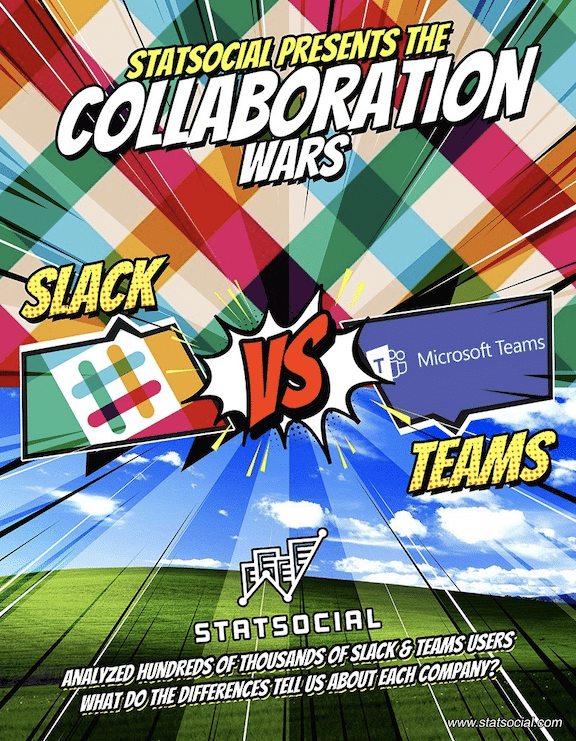
Slack vs. Microsoft Teams: StatSocial Digs Deep into the Collaboration Wars
This is a deep dive comparison of the respective user bases of Slack and Microsoft Teams, made possible with insights unique to StatSocial. Please enjoy our take on “The Collaboration Wars!” and feel free to contact us if you have any questions.
By analyzing the most dedicated users of these competing platforms, across more than 80,000 dimensions (demographics, brand and media affinities, top influencers, personality traits, and more), we’ve ascertained each service’s customers’ priorities, passions, and tribes.
About this project
Time to gather the data & insights below: <10 minutes
Time to analyze data: ~1 hour
Time to write this analysis start to finish: <2 days
Microsoft Teams launched at the end of 2016 and in terms of raw numbers has overtaken Slack as the market leader. But key differences between the user bases are emerging and these distinctions are important for marketers and strategists to understand as the industry continues to develop.

First — a quick primer on the competing platforms (feel free to skip ahead if you are well-versed in both).
SLACK
Not long after Slack’s 2013 launch, many enterprises — billion dollar corporations and scrappy startups alike — regarded the platform as something almost heaven sent. Suddenly businesses of radically diverse needs, but with disparate, yet frequently collaborating departments, spread out within huge workspaces, or across the globe, could connect as though their desks were right next to each other. Businesses with a substantial portion of their staffs working remotely were suddenly provided an office, of a sort, to which everyone could could go each day, simply by opening a desktop app.
Any and all teams could stay on the same page, and share documents, assets, and the like, with an ease, speed, and clarity that, for a great many, surpassed all previous communication solutions; phone, fax, email, messenger, chat programs, carrier pigeon, all seemed archaic and inefficient by comparison.
During Slack’s first handful of years on the market, the cloud-based, all-in-one, team communication tool was lovingly adopted by a number of companies. Overnight it was integrated into day-to-day operations, and became an indispensable business tool, increasing communication and productivity in nearly all areas. It provided instant solutions to problems big and small, and cured ills with which many enterprises didn’t even know they were afflicted.
As of 2019, Slack has reported that they have over 10 million daily active users, which is some notable growth from the 4 million using the platform in 2016. About 88,000 teams opt to pay for one of Slack’s premium plans.
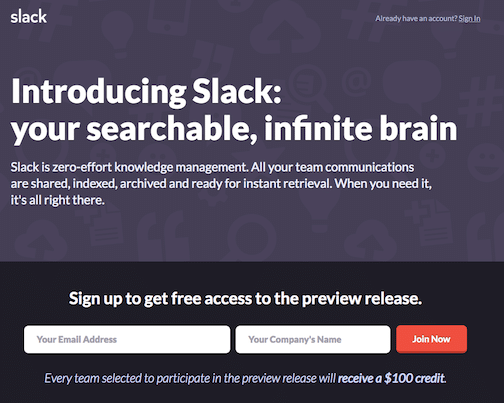
In its early days, six years ago, Slack’s website described the many useful tools comprising their platform as a “searchable infinite brain.” With Slack, all team communications — be they one-on-one, or company wide, and with all attachments and links intact— are indexed, archived, and effortlessly retrieved.
At first glance one could mistake it for gussied up chat software, but Slack is a great deal more sophisticated than that.
A vast array of apps are available, to allow enterprises to tailor their Slack experience to suit specific business and communication needs. They’ve also integrated a number of third party apps and softwares. Rather notable and useful is the way their services play exceptionally nice with Google’s numerous tools, many of which have become crucial to businesses big and small.
Slack and their “email killer” team workflow tools were revolutionary for many businesses, facilitating instant communication and in turn increasing collaboration, morale, invention, and efficiency.
MICROSOFT TEAMS
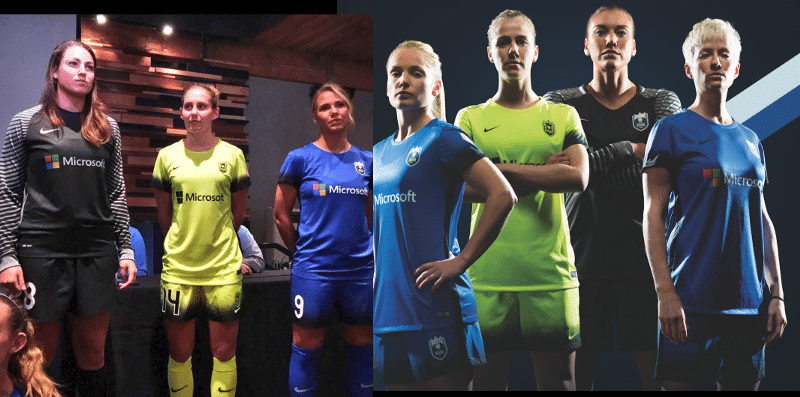
While Slack didn’t dominate the market (that they themselves had essentially invented) without any competition, for a long while they did so without meaningful challenge. That is until November of 2016.
A widespread rumor suggests that at the start of 2016, Bill Gates and Satya Nadella — respectively the founder and CEO of Microsoft (which is likely known to all) — considered putting in an $8 billion bid to acquire Slack. As the story goes, they ultimately decided to instead develop Microsoft’s own group chat app. That autumn, Microsoft Teams was announced.
Slack’s CEO, Stewart Butterfield, did not pretend to ignore the entry of competition from one of the world’s largest corporations, but instead took out a full-page ad in the New York Times directly addressing the matter in detail (the text of the ad — an open letter to Microsoft — is readable on Slack’s blog here).
As things have shaken out, as of this writing, Microsoft Teams is the market leader in terms of raw numbers; currently boasting 13 million users daily. Teams comes bundled with Microsoft Office 365 ProPlus, and some parties have suggested their numbers do not reflect reality entirely.
Butterfield, seemingly unfazed by the ascent of Teams, recently compared Microsoft’s hard push of the product to the billions of dollars they spent on the Bing search engine. He also cited Google’s ultimately failed attempts to salvage the now defunct Google+ by integrating it with all of their other services.
Both Slack and Teams are well-regarded by users. They provide different experiences, and appeal to different sorts of enterprises and groups. Slack has a warmer and quirkier feel, and the experience is more customizable. It feels like the virtual workplace experience that it aspires to provide.
Teams, on the other hand, integrates seamlessly with not only Microsoft’s warhorse Office suite — with such workplace essentials as Word, Excel, etc — but also the Microsoft owned Skype. The platform, thus far, apparently, doesn’t play as well with third party apps, but — taking for granted that such shortcomings will be addressed —to say that Microsoft’s products are nearly exclusively the softwares driving a majority of workplaces is not really hyperbole.
Our research reveals the audiences for each platform to be similar, but not the same. Let’s get into it.
Enter StatSocial — a Quick Primer on the Data Below
StatSocial’s data is sourced from earned engagement (e.g. what people read, like, follow, share, talk about, etc.) of over 300 million consumers. Our analysis of all the content people engage with creates over 80,000 unique attributes per consumer. As a result, we provide an in-depth breakdown of an audience’s interests, affinities, media preferences, hobbies, allegiances, to which of our Digital Tribes they belong, and thanks to our partnership with IBM Watson™ and the integration of their Personality Insights™ service into our analysis, even personality types.
Our reporting reveals things that could not feasibly be learned through hundreds or, truthfully, hundreds of thousands of surveys and focus groups. StatSocial peers beyond the manicured and curated identities of social media, and digs into what really makes the various segments of any given audience tick.
While what you’ll find below may seem like a lot of data, it is only the tip of the iceberg of the insights StatSocial has on offer, regarding these (and all other) audiences. That said, we’re experts at tailoring the analysis to our users’ needs, so the data is never overwhelming.
An Explanation of the Insights Below:
The insights below are mostly sorted according to our index score. The score shows the degree to which the corresponding demographics, behaviors, and/or affinities being reported either exceed, are in line with, or fall short of the baseline. For this study, the baseline we’re using is the average American across the web.
— — — — — — — — — — — — — — — — — — — — —
DEMOGRAPHICS
We should always begin with the most fundamental of insights, which is what we’re doing here.

Comfortably over one-third of the Slack core audience is female. While that does fall well short of the baseline, that greatly exceeds the female portion of the Microsoft Teams customers here.
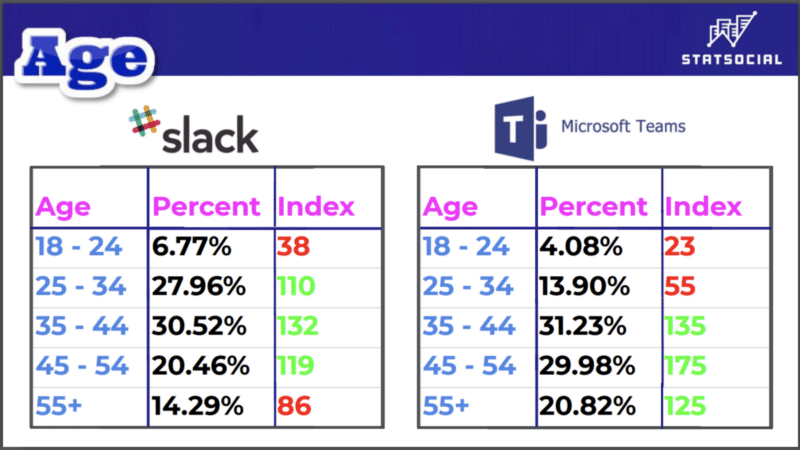
Appealing, as they do (and are), to startups and smaller companies, it’s not entirely shocking that Slack has the younger audience here.
Also worth noting, the portion of the Microsoft Teams audience that is 55-years or older exceeds the baseline by one-and-a-quarter times.
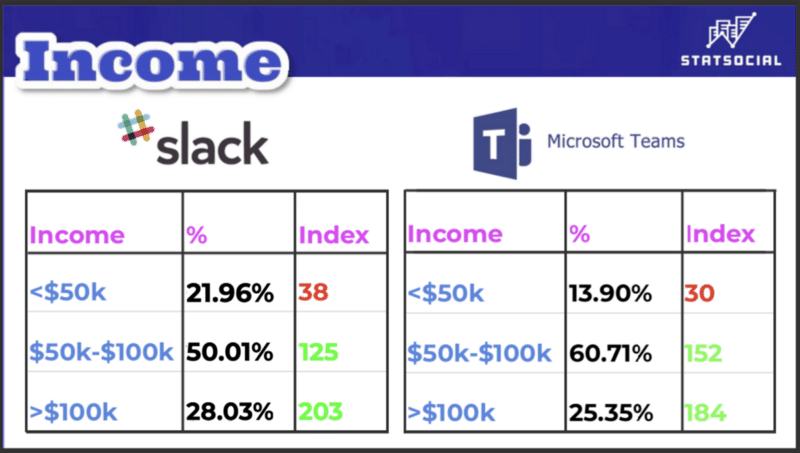
We could already take for granted that very nearly all customers being analyzed here are working. It seems, however, that they are also well-employed. The portions of both audiences earning over $100k a year exceed the earnings of the average U.S. social media audience by 2.03 and 1.84 times respectively.
— — — — — — — — — — — — — — — — — — — — —
LOCATIONS
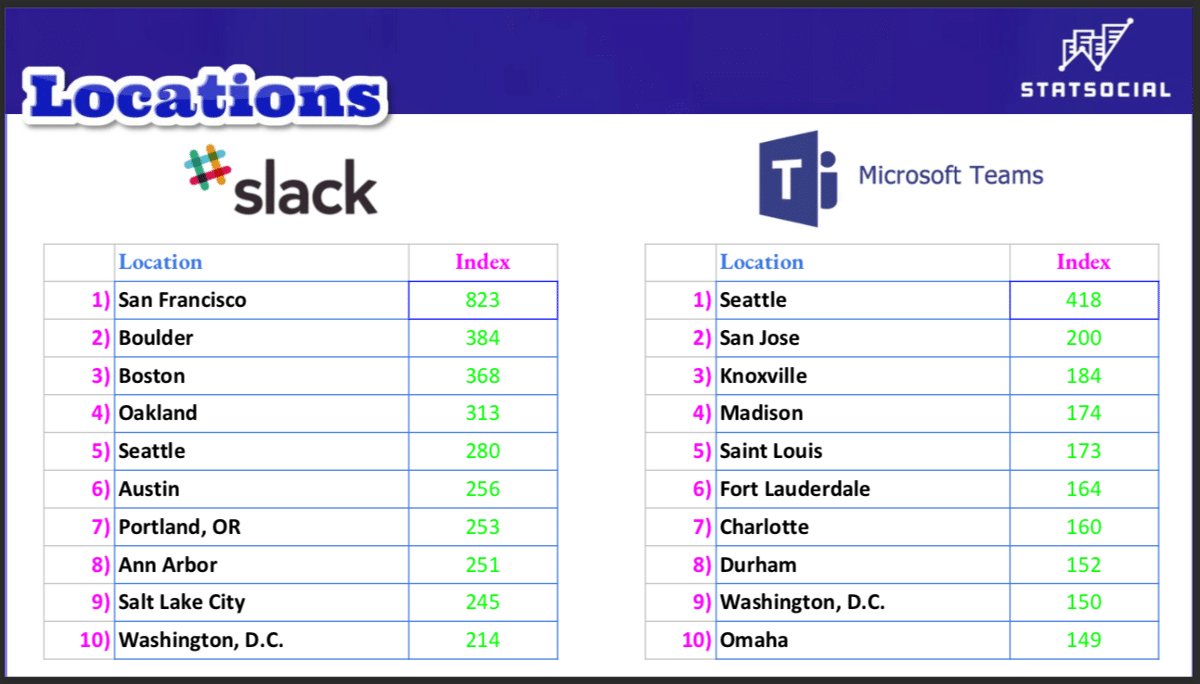
The headquarter city of each platform tops their respective lists, but after that things get a lot more interesting. Knoxville, Ann Arbor, Madison, Omaha, Austin; both platforms find favor in cities with vibrant startup cultures.
The degrees to which Slack’s consumers are over-indexed within their cities of residence is notably more dramatic than the same metrics for Microsoft Team’s audience.
— — — — — — — — — — — — — — — — — — — — —
BRANDS
Because so many of the top brands, with each group of customers, are explicitly tech related, we have broken out the lists by both tech and non-tech brands.
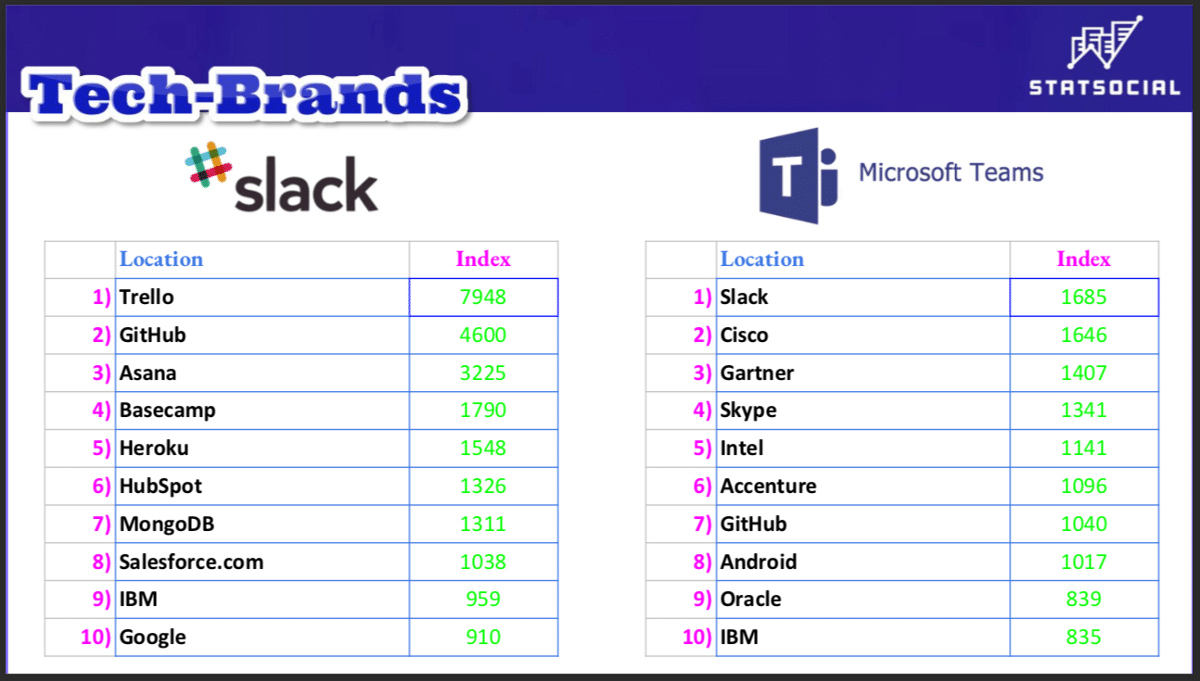
It is surely worth noting, in this context, that the top brand among Microsoft Teams’ most dedicated customers is Slack. Indeed, the portion of their customers who are fond of Slack exceeds our baseline by 16.85 times. What that tells us is that there are a lot more Teams users who also use Slack than vice versa.
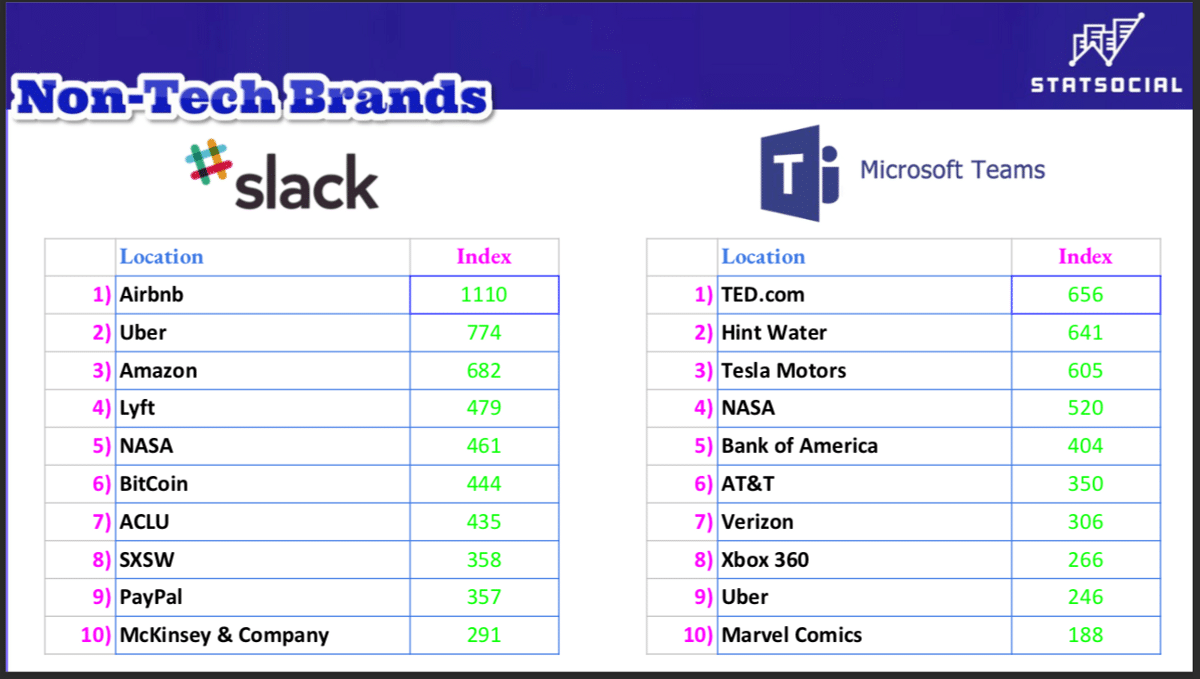
Internet companies, and other brands reflecting a fondness for technology — such as Tesla Motors — can be found here on both sides. Curiously, the Microsoft Teams side includes more leisurely concerns such as (the Microsoft-owned) Xbox and Marvel Comics.
Austin, Texas’ annual South By Southwest festival finds favor with the Slack crowd to a degree exceeding the baseline by 3.58 times.
— — — — — — — — — — — — — — — — — — — — —
INFLUENCERS
Shockingly, given what we’ve learned thus far, there is neither a Jeffree Star nor a Kylie Jenner to be found below.
Instead, tech gurus, billionaires, and entrepreneurs seem to hold the biggest sway with the most loyal customers of each brand.
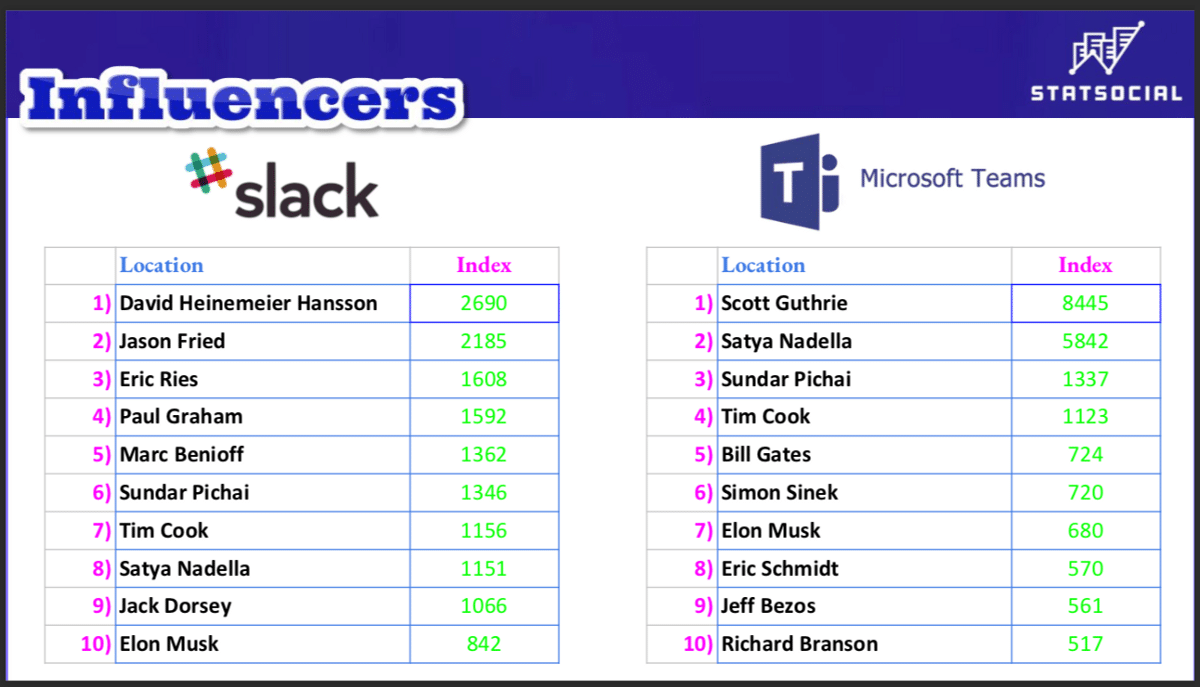
— — — — — — — — — — — — — — — — — — — — —
INTERESTS
These are more broad, top-level, general interests. But they do nothing to dispel the narrative thus far suggested within this entry.
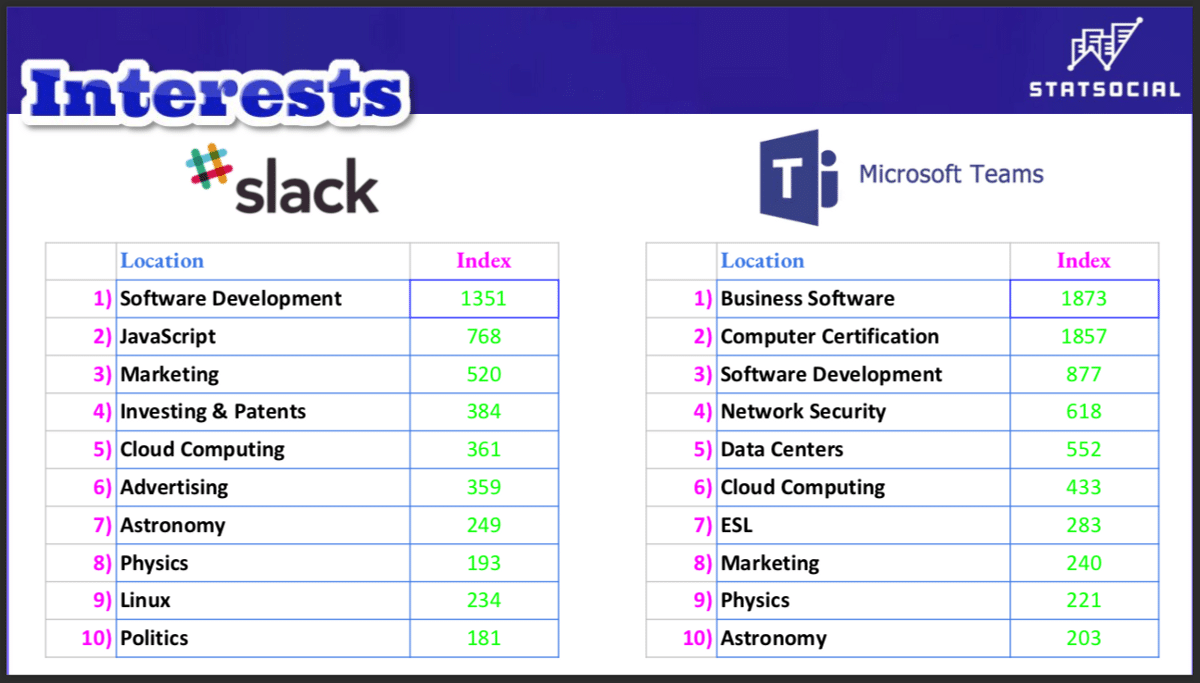
Each customer-base deviates from its primarily techie/scientific interests with one entry each.
For Slack, politics stands out, the portion of their customers displaying interest in that area exceeds the baseline by 1.81 times. Microsoft Teams’ users contain a portion with a demonstrated interest in English as a Second Language that exceeds the baseline by 2.83 times.
— — — — — — — — — — — — — — — — — — — — —
DIGITAL TRIBES
You can read a blog entry detailing this very special set of data by clicking this link, but we’ll also summarize things here.
StatSocial Digital Tribes is a model of the U.S. population broken down into 100 distinct market segments. Seeing which Tribes are present, and in what proportions, grants our users quick, crucial, and unprecedented insight into the humans who make up a given audience.
Combining our demographic and affinity data, with our Personality Insights® (powered by IBM Watson), we have been able to gather these utterly singular segmentation models. Both sides of the data coin are factored in — the demographic and the psychographic — enabling StatSocial to provide brands, publishers, media buyers, and agencies a comprehensive, in-depth understanding of their target audiences.
The graphics below show the 10 best represented Tribes among each of the audiences being explored. An ever-so-brief summary of the shared affinities, demographics, and/or personalities of each tribe is then provided.
More in-depth descriptions of each Tribe referenced below, and the remainder of our 100 Digital Tribes can be seen by clicking here.
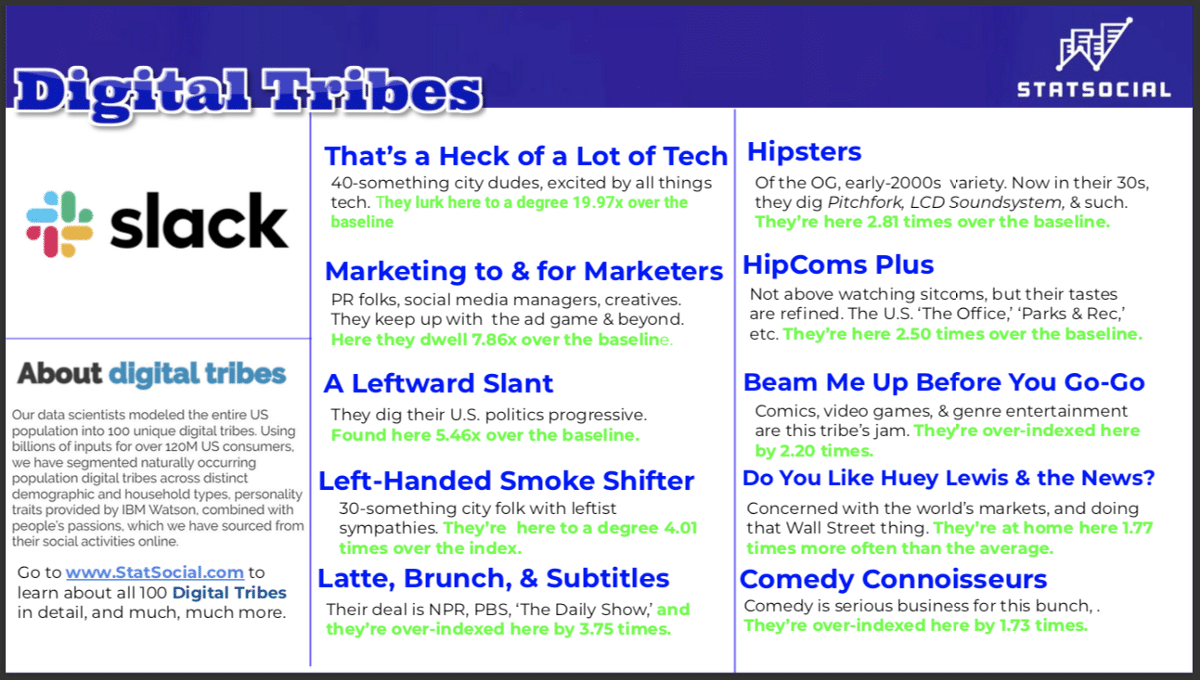
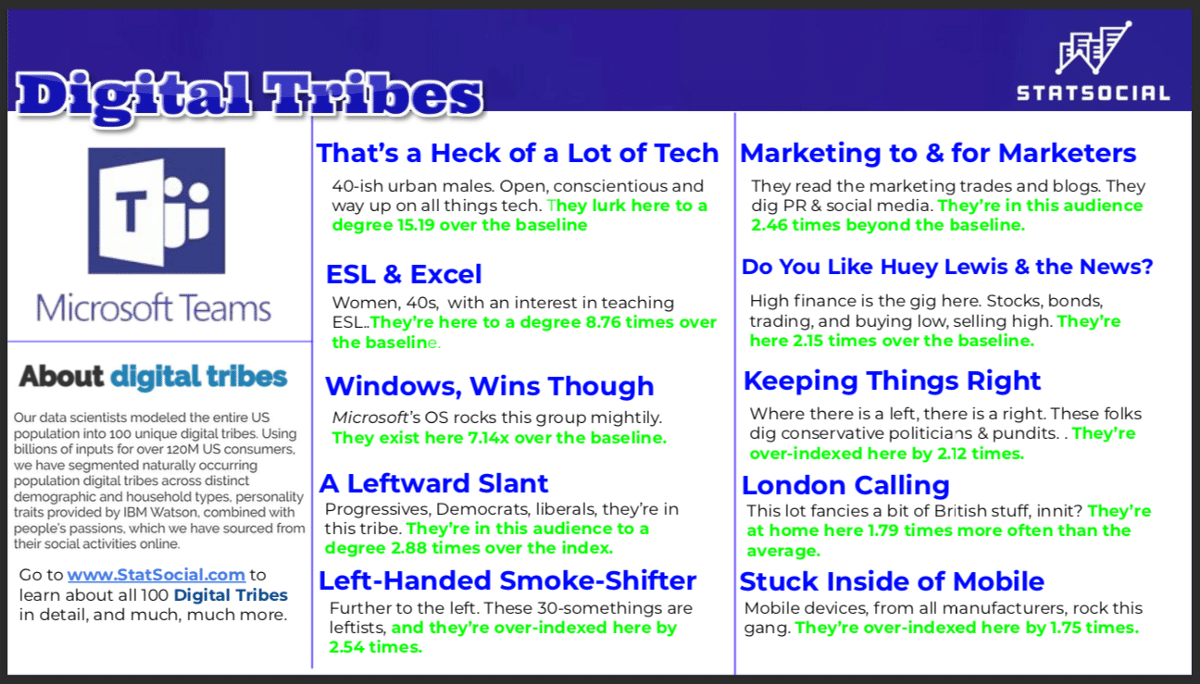
— — — — — — — — — — — — — — — — — — — — —
PERSONALITY INSIGHTS (powered by IBM Watson™)
As was just referenced in the Digital Tribes section…
Among the great many things StatSocial will tell you about any audience, one of the most distinctive, revealing, and essential, is a breakdown of the various personality types to be found among the group that is under our microscope.
Thanks to StatSocial’s proud partnership with IBM Watson™ and the integration of their Personality Insights™ service into our reporting we can report on 52 unique personality traits with as much confidence as we do those metrics which to some might seem more concrete.
Visit IBM Watson’s site here to learn more about what they do.
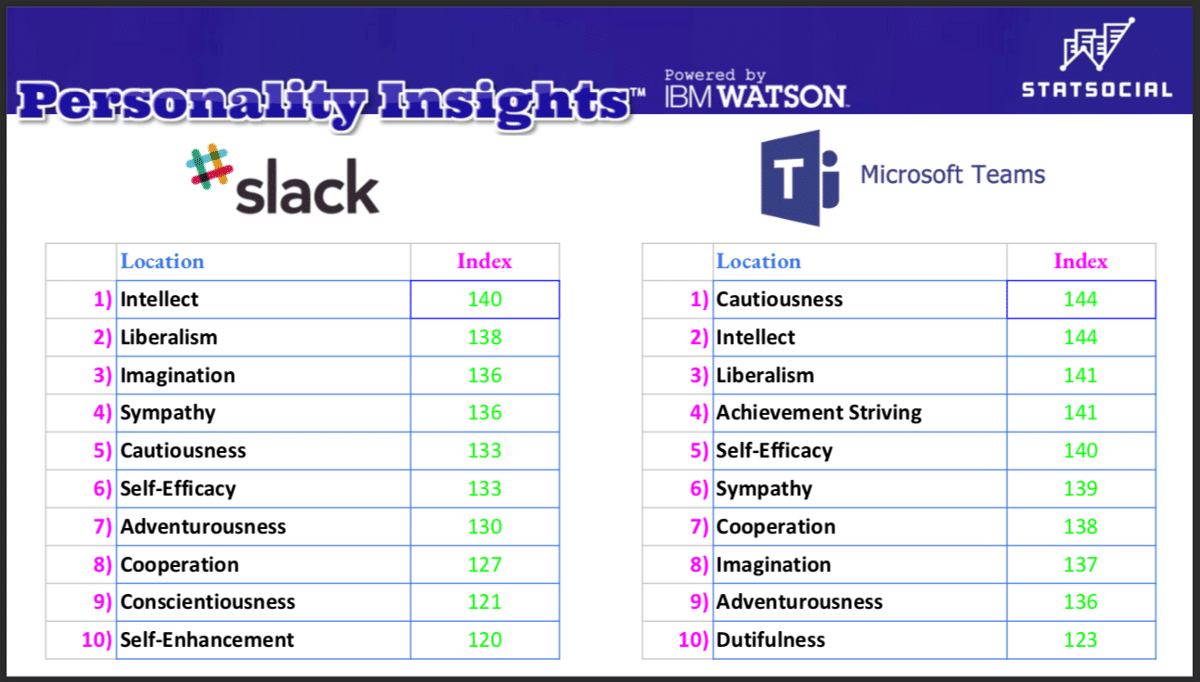
— — — — — — — — — — — — — — — — — — — — —
This only scratches the surface of the data available for each of these audiences, but it does seem consistent with the thesis presented at this entry’s opening
Each platform seems best suited to a certain type of enterprise. With Microsoft you get something more slick, with a fully integrated battery of apps used constantly in far more American workplaces than not. It serves its purpose directly and well. With Slack — for as big as the company has gotten — you get a product that allows for more personalization, and an experience that can incorporate the peculiarities and personalities of your team.
The audiences of each service are similar, but different in ways consistent with this perception.
There’s a great deal more to be learned here, though (or perhaps you’d prefer to learn something directly related to another industry, or an entirely different company, product, or platform). Reach out to StatSocial and we’ll gladly talk to you about it.
— — — — — — — — — — — — — — — — — — — — —
Take a Sniff Around
Insights on top of insights can be found by the curious reader who chooses to poke around the StatSocial blog here. Peruse the many entries, offering all kinds of insights, studies, and deep dives to better acquaint you with the capabilities of StatSocial.
Throughout the blog are many examples of the sorts of insights that can only be gained with StatSocial.
— — — — — — — — — — — — — — — — — — — — —
To learn more or request a demo, click here.
